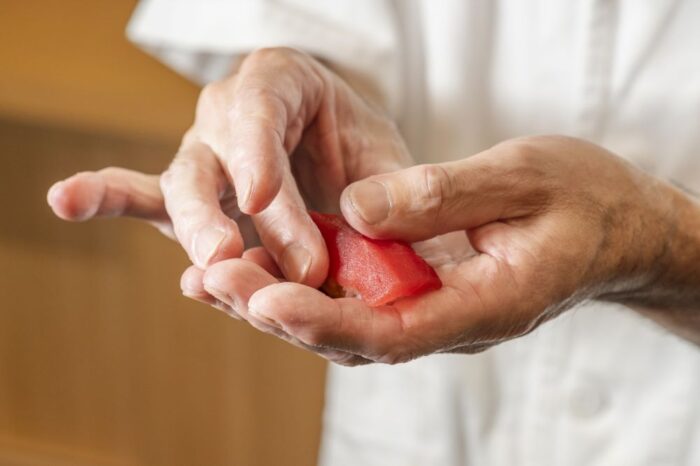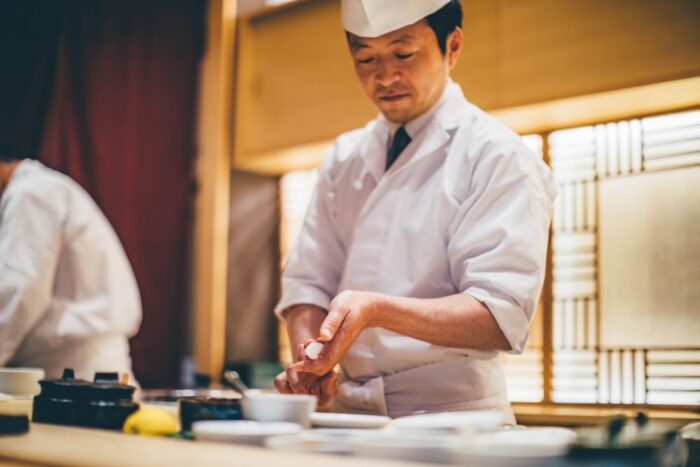Sushi and omakase are two unique dining experiences in Japanese cuisine.
Sushi allows customers to order individual pieces or pre-made dishes from a menu, while omakase is a fixed-price experience where the chef makes all the decisions.
With sushi, the focus is on individual dishes featuring various types of fish or seafood. On the other hand, omakase offers a multi-course meal with dishes that complement each other.

Originating in Japan, omakase sushi has gained global popularity for its elevated and personalized experience, showcasing the creativity and expertise of chefs.
In an omakase sushi experience, the chef curates the entire meal with fresh and unique ingredients, progressing from lighter to heavier dishes, including handcrafted sushi pieces.
To fully enjoy this culinary adventure, making a reservation is recommended, as omakase restaurants often have limited seating for a more intimate dining experience.
Key Takeaways
- Sushi involves ordering individual pieces or pre-made dishes, while Omakase Sushi is a fixed-price dining experience where the chef makes all the decisions.
- Sushi focuses on individual dishes featuring different types of fish or seafood, whereas Omakase Sushi is a multi-course experience with dishes that complement each other.
- Omakase Sushi originated in Japan and is rooted in cultural values of trust and respect, and it has gained popularity globally as a style of dining.
- Omakase Sushi offers an elevated and personalized dining experience, showcasing the creativity and expertise of chefs, with attention to detail in presentation.
The Origins and Cultural Significance of Omakase Sushi

Omakase Sushi originated in Japan. It is deeply rooted in cultural values of trust and respect. This unique dining experience showcases the creativity and expertise of the chef. It offers an elevated and personalized sushi experience. It has gained popularity globally as a style of dining that allows for a high level of customization.
The chefs undergo rigorous training to perfect their sushi-making skills. Their expertise and artistry are evident in each sushi piece. Omakase Sushi provides an exceptional and personalized dining experience. The chef curates the entire meal with fresh and unique ingredients.
The tradition of Omakase Sushi highlights the importance of trust between the chef and the diner. It creates an intimate and memorable culinary journey.
The Artistry and Expertise of Omakase Sushi Chefs
The artistry and expertise of the sushi chefs in an omakase experience are evident in the meticulous presentation and unique flavors of each handcrafted piece. These skilled chefs have honed their craft through years of training and practice, resulting in a truly exceptional dining experience.
Here are four reasons why the artistry and expertise of omakase sushi chefs evoke a sense of freedom and delight in their audience:
- Every sushi piece is a work of art, meticulously crafted with precision and creativity.
- The chefs use the freshest and highest quality ingredients, resulting in a symphony of flavors that tantalize the taste buds.
- The attention to detail in the presentation creates a visually stunning feast for the eyes.
- Each bite takes you on a journey of flavors and textures, allowing you to savor the moment and experience the true artistry of sushi.
In an omakase experience, the chefs’ expertise and dedication to their craft shine through in every aspect, giving diners the freedom to indulge in a truly unforgettable culinary adventure.
The Unique Elements and Personalization of an Omakase Sushi Experience

An omakase sushi experience offers a unique and customized dining adventure. With its incorporation of seasonal ingredients and personalized menu, it puts the chef in control of the entire dining experience. Unlike traditional sushi, where customers choose individual pieces from a menu, omakase sushi curates a multi-course meal that progresses from lighter to heavier dishes. This showcases the chef’s creativity and expertise. Each dish is carefully crafted to complement the flavors and textures of the previous one, resulting in a harmonious and unforgettable dining experience. The use of seasonal ingredients ensures that the sushi is fresh and flavorful. The chef’s meticulous attention to detail in presentation adds an extra level of sophistication to the meal. Overall, an omakase sushi experience provides a personalized and exceptional dining adventure for those seeking freedom and a truly unique culinary experience.
How to Prepare for an Unforgettable Omakase Sushi Dining Experience
To fully enjoy an unforgettable omakase sushi dining experience, individuals should approach the meal with an open mind, ready to embrace new flavors and textures. Here are four key tips to help prepare for this unique culinary adventure:
- Embrace the Unexpected: Omakase sushi is all about the element of surprise. Be prepared to try ingredients and combinations you may have never tasted before. This freedom to explore new flavors is what makes the experience so exciting.
- Trust the Chef: The chef is the expert, so trust their expertise and let them guide you through the meal. They have carefully curated each dish to create a harmonious progression of flavors.
- Appreciate the Artistry: Take the time to admire the skill and creativity that goes into each sushi piece. Notice the attention to detail in the presentation and savor each bite, knowing that it has been crafted with precision and care.
- Be Present: Immerse yourself in the moment and fully appreciate the experience. Put away distractions and focus on the flavors, textures, and aromas of each dish. This freedom to be present allows you to truly savor and enjoy the omakase sushi dining experience.
Exploring the Cost and Value of Omakase Sushi
Exploring the cost and value of omakase sushi reveals the personalized and curated nature of the dining experience, which contributes to its higher price point.
When dining omakase style, customers are treated to a unique and customized culinary journey guided by the chef’s expertise and creativity. This personalized approach ensures that each dish is carefully crafted to complement the others, resulting in a harmonious and memorable meal.
The price of omakase can vary depending on factors such as the restaurant, the chef’s skills, and the quality of ingredients used. While it may be more expensive than ordering sushi à la carte, the value lies in the exceptional quality, attention to detail, and the opportunity to savor a one-of-a-kind dining experience.
For those seeking freedom in their dining choices, the cost of omakase is justified by the unparalleled level of customization and the chance to indulge in the artistry of the chef.
Choosing Between Sushi and Omakase: Decoding the Distinct Dining Experiences
Customers face the decision of choosing between sushi or omakase, as they navigate the distinct dining experiences each option offers. Here are four key points to consider:
- Freedom to Choose: Sushi allows customers to have control over what they order, selecting individual dishes from a menu or display case. This gives them the freedom to try different types of fish or seafood according to their preferences.
- Chef’s Expertise: On the other hand, omakase sushi offers a unique and personalized dining experience. Customers entrust the chef to curate a multi-course meal using fresh and seasonal ingredients. This allows the chef to showcase their creativity and expertise, creating a meal that complements each dish.
- Formal vs. Informal: Sushi dining is often more casual, with customers enjoying a relaxed atmosphere. In contrast, omakase sushi is more formal and intimate, with the chef personally greeting and explaining the menu, considering dietary restrictions, and curating an exceptional dining experience.
- Cost and Value: Sushi à la carte allows customers to have more control over the cost, choosing individual items based on their budget. Omakase sushi, with its personalized and curated nature, tends to be more expensive but offers a higher level of customization and an elevated dining experience.
Ultimately, the choice between sushi and omakase depends on the customer’s desire for control, the chef’s expertise, the formality of the dining experience, and the value they place on a personalized and curated meal.
Frequently Asked Questions
What Is the Significance of the Term “Omakase” in the Context of Sushi Dining?
The term ‘omakase’ in the context of sushi dining signifies a personalized and curated dining experience. The chef makes all the decisions, selecting fresh and unique ingredients to create a multi-course meal that showcases their expertise and creativity.
How Long Does an Omakase Sushi Experience Typically Last?
An omakase sushi experience typically lasts around 1.5 to 2 hours. The chef carefully crafts a multi-course meal with fresh and unique ingredients. Each dish is presented with attention to detail, making the experience truly memorable.
Can I Request Specific Types of Fish or Seafood for My Omakase Meal?
Yes, diners can request specific types of fish or seafood for their omakase meal. The chef will consider these requests and incorporate them into the curated dining experience, ensuring a personalized and enjoyable meal.
Is It Common for Omakase Sushi Chefs to Interact With Diners During the Meal?
Yes, it is common for omakase sushi chefs to interact with diners during the meal. They may explain the dishes, answer questions, and provide insights into the ingredients and preparation techniques, enhancing the overall dining experience.
Are There Any Specific Etiquette Rules or Customs to Follow When Dining at an Omakase Sushi Restaurant?
There are specific etiquette rules to follow at an omakase sushi restaurant. Diners should arrive on time, respect the chef’s choices, and eat sushi with their hands. It’s important to savor each bite and show appreciation for the chef’s skill.
Conclusion
In conclusion, the difference between sushi and omakase is clear. Sushi allows diners to order individual pieces or pre-made dishes from a menu, while omakase is a fixed-price dining experience where the chef makes all the decisions.
Omakase sushi originated in Japan and has gained global popularity for its elevated and personalized dining experience. With fresh and unique ingredients, the chef curates a multi-course meal that progresses from lighter to heavier dishes, culminating in handcrafted sushi pieces.
To truly appreciate the artistry and expertise of omakase sushi chefs, making a reservation is recommended for an unforgettable dining experience.




